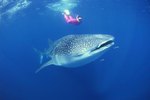
Sharks are one of those animals that have the ability to strike fear into the hearts of just about anyone, including their smaller brethren. Large predatory sharks aren’t picky eaters. Great whites, hammerheads, tiger sharks and bull sharks aren’t strangers to cannibalism, frequently making a meal out of smaller species.
Great White Sharks
Capable of reaching lengths over 20 feet, great white sharks are the largest predatory fish in the world. Great whites are easily recognized by their huge mouths full of 300 knife-like teeth, gray bodies and white undersides. Great whites can clock 15 miles an hour, launching themselves out of the water to capture prey from below. Great whites will eat just about any fish that can fit in their mouths, including smaller sharks. Their favorite food however is elephant seals. Nearly half of all shark attacks involve great whites. Humans aren’t on the menu, but great whites will take an investigative bite of just about anything, letting it go if they don’t think it’s tasty. Great whites are found in oceans all over the world.
Great Hammerhead
The great hammerhead is the largest of all hammerhead shark varieties. Hammerheads can grow to 20 feet long and weight up to 1,000 pounds. Hammerheads are easily identified by their strange looking heads, with eyes set on either side of a wide, flat head that resembles a hammer. Great hammerheads are olive green on top with cream-colored bellies. Hammerheads love to eat bony fish and sting rays, as well as smaller species of shark. Great hammerhead sharks can be found in oceans across the globe.
Tiger Shark
Tiger sharks are identified by the vertical stripes that run along their bodies, similar to tiger stripes. Behind only great whites, tiger sharks are the second most dangerous shark to humans. Tiger sharks have the nickname “wastebasket of the sea” because they will eat anything they can fit in their mouths. Tiger sharks have not only been known to eat smaller sharks, but snakes, turtles, seals, squids and even tires and other trash. Tiger sharks grow up to 14 feet and are found in shallow coastal waters throughout most of the world.
Bull Shark
Bull sharks get their name partly because of their tendency to head-butt their prey and their prickly disposition. Bull sharks grow to about 12 feet long, have rounded, blunt snouts and are gray on top with white undersides. They make themselves at home in coastal waters across the planet, but are one of the few species of shark that can survive in brackish or even fresh water for long periods of time. They will often make their way inland via rivers, bringing them in close contact with humans in more places than just the beach. They are considered the third most dangerous shark to humans. If a bull shark can catch it, a bull shark will eat it. Bull sharks will eat dolphins, fish and other, smaller sharks.
References
Photo Credits
-
Thinkstock/Comstock/Getty Images



